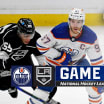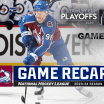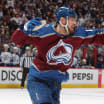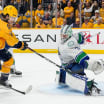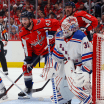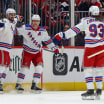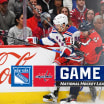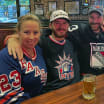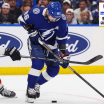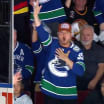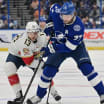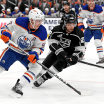Goaltending plays an integral part in the Stanley Cup Playoffs so NHL.com is breaking down the battle between the pipes in each series this season, charting goals to find strengths, weaknesses and targetable tendencies.
The Minnesota Wild are set with Devan Dubnyk; however, between their injuries and the Dallas Stars' firepower, they may need him to repeat the late-season run that made him a Vezina Trophy finalist last season if they are going to win this series.
The Stars are decidedly less settled in goal, with the possibility they may continue a regular-season trend of splitting time between the Finnish tandem of Kari Lehtonen and Antti Niemi that finished the year with near identical numbers. The suspicion is Dallas will start with Niemi, who won the Stanley Cup in 2010 with the Chicago Blackhawks. But it will be interesting to see whether the Stars switch back and forth, because even though the stats are similar, there are style differences between Niemi and Lehtonen. While the Stars' players should be used to those by now, it could throw off the scouting report of Wild shooters.
Dubnyk stands tall against Niemi, Lehtonen
Wild goalie has slight edge over Stars' tandem

© Michael Martin/Getty Images
POSITIONING: Dubnyk resurrected his career last season by getting stronger physically and tighter technically, including better depth management born out of a simple rule he learned from then-Arizona Coyotes goaltending coach Sean Burke: If he can't beat a pass on his skates, he's too far out. That, combined with improved tracking that allowed him to move laterally without opening up as much as he used to, formed the foundation of his turnaround; however, it also leaves him playing well back in his crease, reliant on the coverage of a 6-foot-6 frame and active hands to close down the top of the net.
Lehtonen is at his best when he isn't overaggressive with his initial positioning, an ongoing quest that seemed to take more with new Stars goaltending coach Jeff Reese this season. The bigger change may be in Niemi's approach, which evolved away from his inside-out roots with the Blackhawks to include a lot more aggression and backwards flow with the San Jose Sharks. He's back to playing predominantly inside the crease now, beating rush plays by establishing an early angle rather than trying to time his retreats to them.
Advantage: Because he's more consistent in his approach, especially compared to Lehtonen, Dubnyk
Video: SJS@MIN: Dubnyk slides over to rob Marleau on PP
BLOCK/REACT THRESHOLD : As big as he is, Dubnyk can't survive playing as deep without keeping his hands active. There are still times when he gets too hunched over in his stance and pulls his hands back as he pushes his knees to the ice, but for the most part they stay out in front of his body and reactive.
Even when he's not chasing with his positioning, Lehtonen tends to reach a lot with his hands, too often chasing pucks that are headed wide. This delays his ability to get to his next position and can leave him stranded high in the crease. Niemi has always reacted up and out with hands he holds low in his hunched-over stance, but does so effectively, especially now that he's set and ready more often.
Advantage: Because he closes on more shots when he reacts with his hands, rather than reaching and opening up,Dubnyk
PUCKHANDLING: None of these three jumps out as particularly strong or active, butLehtonen worked hard on his puckhandling when the Stars transitioned from Marty Turco, who was one of at moving the puck, and has three assists this season. Niemi has two, and while it may just be a function of leaving pucks behind the net to start the high-scoring Stars' transition attack, at least they're getting touches.
Advantage: The edge goes to both Stars, and choosing between them, Lehtonen
POST PLAY: Dubnyk still mixes traditional VH into his post-integration options on dead-angle plays from above the goal line, sealing the short side with his lead pad stacked against the post and the back side pad down on the ice. It's more of a blocking technique, locking up the hands and producing rebounds, but Dubnyk at least uses it as more of reactive save selection rather than defaulting to it prematurely.
Niemi is no longer using VH with his skate outside the post, a move that other teams were targeting with backdoor plays in San Jose because of the inherent delays getting across the crease. Lehtonen does like to overlap the post and square up in the butterfly on shots from the bottom of the circle, however, and both Stars goalies will put their pad inside of the post, rather than their skate on it, when they move have to move quickly into reverse-VH, which seals the post better, but delays movements off it.
Advantage: Because Dubnyk's deep position and wide stance sometime leave him caught up on the post and exposes the short side, Lehtonen and Niemi
Video: COL@DAL: Lehtonen denies pair of shorthanded chances
SCORING TRENDS: Dubnyk tracks and moves better to this glove side than his blocker. This not only causes him to pull off shots on his right and limits his blocker extension, but it also delays him getting across and set to that side, and slows his recoveries to the right, which also leads to more reaching.
It was easier to find exploitable tendencies on Niemi last season with all the extra movement, especially off the rush, but he is playing a more neutral game since coming to Dallas. Lehtonen still has a habit of chasing pucks unnecessarily with reaching hands, and despite narrowing his stance on end-zone play can still get spread out low and wide off the rush. But he isn't getting stranded as often with his positioning.
Advantage: The diversity of the Stars' duo makes it harder to isolate trends that can be targeted, especially when compared with Dubnyk's consistently deeper approach, but it's still Dubnyk
